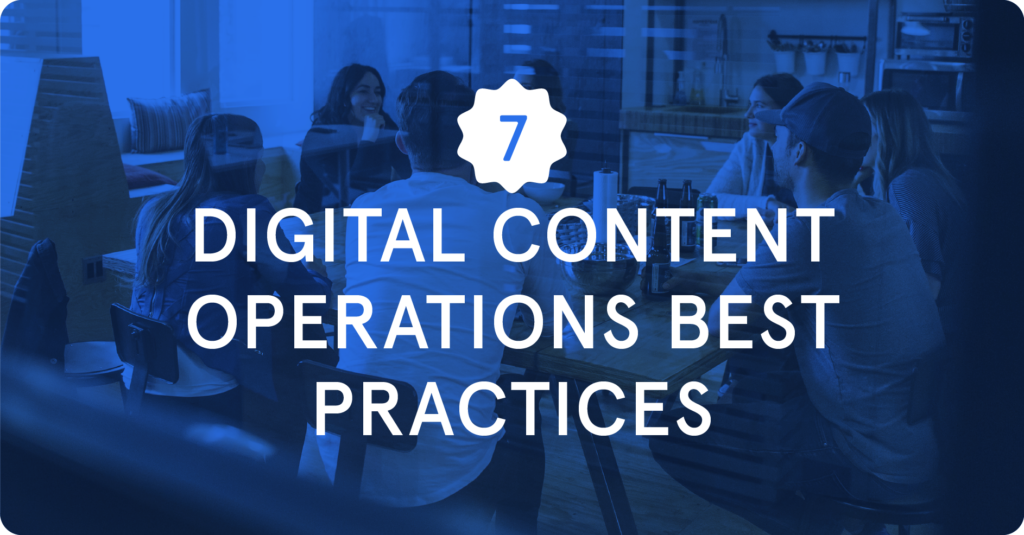by Lee Dussinger
Content is the cornerstone of how your brand shows up online. Every post, video and campaign contributes to that online presence. What content looks like for each brand may differ – but the objective is the same: content is the primary way your audience will interact with your brand in digital space.
As content continues to be one of the most pivotal ways consumers experience a brand, the need for process improvement becomes even more pronounced. This is driven by the continuous expansion of channels. Marketers are now expected to create great content for more channels than ever before.
From the planning stages through the production and analysis stages, digital content operations governs the process of creating marketing content for digital spaces. Everything from a long-form blog, to a social post, all the way to an omnichannel digital marketing campaign, fits under this umbrella. Essentially, digital content operations is the standard content operations framework applied to exclusively digital content production.
If you need a refresher on the standard framework – we explore the full model in depth right here.

We’re highlighting the best practices that can help a marketing team manager or director as they adopt this framework for their digital content.
Explore these 7 content operations best practices that can apply to almost any organization:
1. Identify & Prioritize Your Needs

While the content operations framework is a complete model, you’re free to mold it to your needs, as a way to solve your pain points. Since content production is covered from beginning to end, you’re certain to find something you can use.
When planning your process, start by identifying where your team needs help and then look for relevant solutions. This begins with an audit of your current workflows to identify areas for improvement.
Here are some common examples of problems and their solutions:
- Problem: Brainstorming is challenging and team members have difficulty committing to an idea
- Pro Tip: Find your virtual whiteboard
- Problem: Content approvals are time-consuming or confusing
- Pro Tip: Recommend against chat and email approvals
- Problem: Your team never knows what other teams/brands/product lines are publishing
- Pro Tip: Create a central marketing calendar to be shared across multiple teams
2. Have the Team Buy In
Adopting a digital content operations framework benefits every single person on your team. Of course, they have to see it that way…
These new tools, tactics, and processes will change how everyone on the content production team (and maybe even some adjacent teams) works everyday. When you don’t have team buy-in, they may not see the value in adopting these processes.
In order to secure that essential team buy-in, we recommend involving the whole team in the decision making. When they see that elements of a content operations framework will improve their efficiency and eliminate busywork, they’re more likely to be champions for this new process.
Involving them in the decisions can look like:
- Ask team to research and propose different solutions
- Include the team in trials and demos
- Invite suggestions for new processes
- Share content ops resources so the whole team understands the framework
- Reinforce that this is here to help EVERYONE
- Share case studies of how much time can be saved and how much busywork can be eliminated (learn how Microsoft achieved 67% faster content production)
3. Set Goals For Content Operations

Implementing a digital content operations framework isn’t about achieving some nebulous idea of “productivity” – it’s about making a real, measurable difference. If you implement these processes correctly, your teams will certainly feel the alignment and experience the efficiency. But it’s more than just that…
By investing in this discipline, you want to achieve goals that move the needle for your team and the organization. That’s why one of the content operations best practices is to set concrete goals. You want to identify solutions that can be quantified and measure how you’ve made an impact on them.
Setting and assessing goals for digital content operations is a method to see if your new tactics have been effective. If you’re not seeing results after implementation, keep iterating on them. However, these specifics also give you results to share for the purpose of proving the value of the investment.
Here are some quantifiable observations you should look for and report on:
People hours saved – Estimate how many hours of busywork tasks (such as manually posting content or building marketing slide decks) have been automated or eliminated. Getting meaningful time back for your team feels great – and you should celebrate that win.
Mistakes prevented – If correcting content mistakes is one of the pain points that has set you looking for a solution, use it here. Being able to observe an appreciable difference in errors can prove the effectiveness of what you’re doing.
Earlier approvals and posting – With stronger approval processes in place, content will be approved and published faster. Keeping track of the number of on-time launches or how many days you cut off content turnaround time is a great example of this.
Read an omnichannel marketing case study to see how an Opal client achieved 95% more on-time campaign launches!
4. Vet Your Software Carefully

Incorporating software solutions are a crucial component of digital content operations. Some challenges require purpose-built solutions that equip your team with a capacity they don’t have now. All of the careful processes in the world can’t turn deconstructed words and pictures into a true-to-life content preview. Only a software solution can do that. This is just one of many examples where software proves essential for operations.
Choosing the right software can make a huge difference in the overall success of your content operations. When software is a good match for the needs of your team, the work you do every day becomes easier. When it’s a bad match, though, using the tool feels like extra work.
So, in the software-saturated marketplace of 2023, how do you know what to choose? You absolutely have to vet any software carefully. Here are a few things to keep in mind when evaluating different platforms:
Look for purpose-built platforms – The best practice is to find solutions made specifically for the problems you’re experiencing. While generic, do-it-all tools have their uses, you’ll get better results from tailor-made software that has functions dedicated to your exact challenges.
Look at the user base – The right tool for your team isn’t just a match for the use case but for the organization as a whole. Some software is better for enterprise organizations – and others are better for smaller teams. When reading reviews, be sure to consider how similar the successful users are to your company.
Customized demo or trial is a must – Even with all of the right features and stellar reviews, you still need to see your solutions in action before you buy.
Resources exist to help you – To make finding the right tech fit easier, there are dedicated resources that compare software solutions in different categories – as well as compile reviews. Two of the most trusted sources are G2 and Capterra.
5. Do What You Can Right Now

While one or more pieces of marketing operations software are likely part of your content operations plan, vetting and onboarding these can take time. This is especially true for larger organizations where lengthy contracting and procurement practices are the norm.
Implementing processes and procedures is a way to make an impact on the content production process right away. Let’s consider how you can overhaul your brainstorming process immediately.
- Instead of having the team think of ideas separately and send pitches in when finished, host a marketing team brainstorm meeting.
- Have a free-form discussion and note all of the ideas, good and bad.
- After the meeting breaks, have everyone vote on and rank the ideas.
- Come back together for a follow-up to hammer out your final choice.
- If needed, publicize the idea to the larger org – or just get started building the content.
This is just one example of how you can flip the brainstorming script to drive more creative ideas – as well as team alignment.
6. Document & Analyze

As you make these changes to your processes and workflows, keep your finger on the pulse of what’s happening. Of course, you’ll want to note what works, where you see the most impact, and where you got tripped up. Even more importantly, though, is to keep track of the feedback you get from your team.
If there are multiple separate marketing or content teams, your findings may be instrumental to helping your peers have an even smoother experience adopting a digital content operations framework.
7. Start Right

While it depends on organizational needs and pressing pain points, generally, implementing some of these content ops strategies before others makes sense. When it comes to where you want to start, consider this…
What will make a noticeable impact – Make your time investment worth it right away. Overhauling your briefing or calendering process can genuinely change how it feels to do your work on a daily basis. That level of impact generally exceeds what you can expect from asset management.
What is easiest to adopt – You want to start with initiatives that can be adopted right away.
That often looks like tackling the processes that live within the marketing team, such as briefing and brainstorming. You’ll be more likely to affect change within your own team – rather than suddenly asking executive leadership to adopt a budgeting and capacity planning process.
What makes sense with the process of content creation – Generally, all teams (and even practitioners) create content differently. However, there is a logical beginning. Unless there is a clear and pressing need elsewhere, start here…
That’s why we recommend starting with these 3 elements:
- Planning
- Creating
- Calendaring
So, what specifically does that look like?
Next Steps to Consider
1. Reinvent how you brainstorm – Content planning starts with brainstorming. Finding your creative flow state can take some experimentation. Like in the example in section 5, we strongly recommend trying to brainstorm campaign ideas together in a shared space. You can take the first step on this front today, simply by scheduling a free-form brainstorm meeting and seeing the results. Of course when you start to involve tools and tech, it becomes more sophisticated. For many of our clients, Opal Boards serves as their brainstorming space – where teams collaborate, ideate, and build standout marketing briefs.
2. Upgrade your content briefs – Don’t think about marketing briefs as an assignment – they are a tool for collaboration. First and foremost, establish briefs as living documents that can be edited, ideated upon, and changed as ideas evolve. If your team frequently receives content requests, formalize the intake process by encouraging better briefing. Encourage everyone to create fully realized and uniform content briefs that can be visible to the entire organization.
Learn how upgrading the content briefing process helped Microsoft bring content to market 67% faster.
3. Create realistic previews – There is a big difference between seeing true-to-life content previews and disconnected text and images. Realistic previews can be an absolute game-changer. Being able to see your work through the eyes of your customer truly changes the way you write, shoot, and design. This one is hard to achieve without investing in technology – make this one of the first software solutions you find.
4. Establish a shared calendar – One of the most essential elements of content operations, a shared calendar provides unparalleled visibility. Not only can you see all your marketing at any given time in one place, but it ensures your brand goes to market deliberately. That means no content gaps, content collisions, or misaligned messages.
Opal: The Purpose-Built Platform
Our mission is to empower marketers to take control of their content through a variety of purpose-built features and key integrations – specifically designed to meet the needs of some of the world’s top marketers…our customers. We’re incredibly honored that some of the most-recognized, most-loved brands – like Target, Starbucks, and Microsoft – plan, create, and calendar their content in Opal.
Here’s how Opal fulfills the plan, create and calendar elements of digital content operations:
Planning
- Dedicated space for collaborative brainstorming
- Customizable content intake templates
- Central storage space for campaign documents
- Convenient cross-team communication
Creating
- True-to-life content previews
- Custom workflows
- Ability to comment directly on work
- Easy approvals
- Auto-build presentations
Calendaring
- Visual calendar that centralizes all marketing campaigns and content
If you’d like to learn more about how the Opal platform can enhance your digital content operations process, you’re in the right place. Schedule a demo with a product expert to see real examples of how Opal can change the way your team works every day.


